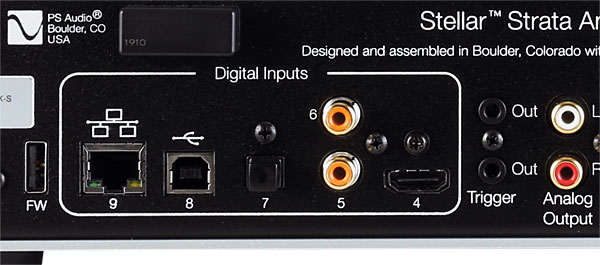PS Audio Stellar Strata Integrated Amp

 Dubbed PS Audio's 'finest all-in-one music component', the Strata combines network streaming, USB and other digital audio inputs with a 'Gain Cell' pre and ICEpower amp
Dubbed PS Audio's 'finest all-in-one music component', the Strata combines network streaming, USB and other digital audio inputs with a 'Gain Cell' pre and ICEpower amp
Browse the catalogue of Colorado's PS Audio and you'll find both monstrous and slimline monoblock amps – the BHK Mono 300 [HFN Jul '16] and Stellar M1200/M700 [HFN Jan '21 and Apr '20], respectively – together with stereo power amplifiers, streaming DACs, integrated amps and preamps. And then there's the Stellar Strata, which in some ways is a distillation of PS Audio's diverse product line and tech into one box.
Living up to its enticing 'just add speakers' status, the standard-width (432mm) metal-chassis Strata – available in either black or silver – combines an analogue preamplifier, wired/wireless streaming module, 384kHz/DSD-capable DAC and Class D amplification rated at 100W/8ohm (and 150W/4ohm). It also accommodates private listening via its full-size headphone output and associated Class A amp, which is rated at 300mW/300ohm. Meanwhile PS Audio aims to simplify your enjoyment of streamed music via its Connect app (free for Android and iOS devices) – and all this functionality is wrapped in a slender, 75mm-tall unit, and given a £2995 price tag.
There is something obviously missing from the Strata's spec sheet, however: a built-in phono stage. And for good reason as PS Audio also sells the Stellar Phono [HFN Feb '20], although as this is priced at £2500, vinyl-loving Strata buyers may well end up looking elsewhere. Other features of the competition, such as Bluetooth integration or room EQ, are also absent.

Déjà View
Styling follows the by-now familiar Stellar template, the series representing the company's near entry-level with only the bijou £800 Sprout100 integrated ranged below. Indeed, the casework here is nigh-on identical to that of the M700 and M1200 monoblocks, and S300 stereo power amplifier, save for the necessary inclusion of a volume control, the front-panel interface and aforementioned headphone output. As such, it looks neat and tidy, if a little conservative.
Rear panel inputs are separated into digital and analogue banks, the former offering two coaxial, one optical, USB-B and an I2S terminal for connection to, for example, PS Audio's PerfectWave SACD transport. The analogue selection comprises three pairs of unbalanced RCA and one balanced XLR input. Sandwiched between is an RCA output for connection to an active subwoofer or external amp, and an auxiliary RCA input set to a fixed volume for use with an AV processor in Home Theatre Bypass mode.

Under the hood, the Strata features an ICEpower Class D amp module fed by PS Audio's fully balanced 'Gain Cell' preamp. Used across the Strata range, this blue block aims to better the performance of a conventional volume control. It uses a combination of IC op-amps and discrete FETs configured into a mixer, but instead of combining (mixing) two audio feeds, it employs a variable DC feed to steer the audio up or down in level. How well this works is heavily influenced by the matching of the transistors in each half of the cell [see HFN Apr '20].
Taking Control
The Strata's remote handset shows PS Audio has been paying attention to developments in the wider consumer electronics world, as it has a distinctly un-hi-fi feel to it. Eschewing the trend for aluminium bricks with minuscule buttonry, it's sleek, compact and delivers sensibly placed volume controls, access to digital filter and phase tweaks, and direct keys for inputs. The only blot on its copybook is the numerical labelling of these latter buttons, which means you'll need to remember, for example, that input #7 is optical and input #9 is streaming. Yes, you can rename the inputs displayed on the Strata itself, but not on the remote control...
The amp's front panel window shows the current volume (and can be dimmed entirely if you want), but it's also the interface for accessing deeper features, including Wi-Fi set-up, balance control, and trims for headphone output and input volume. Making adjustments is somewhat fiddly while the small display – barely an inch tall – means close inspection is required. The same limited visibility applies to track metadata or the sample/bit-rate information that is displayed with streamed sources.
I'll also admit to being a little wary of the PS Connect app, as posts on the company's online forum suggested there have been teething issues since it launched last summer. However, once the Strata was connected via wired Ethernet (it repeatedly drew a blank with my Wi-Fi network) the Android app automatically located the amp, and just a couple of minutes later I was playing music from my Tidal account via a user-friendly interface.

























































